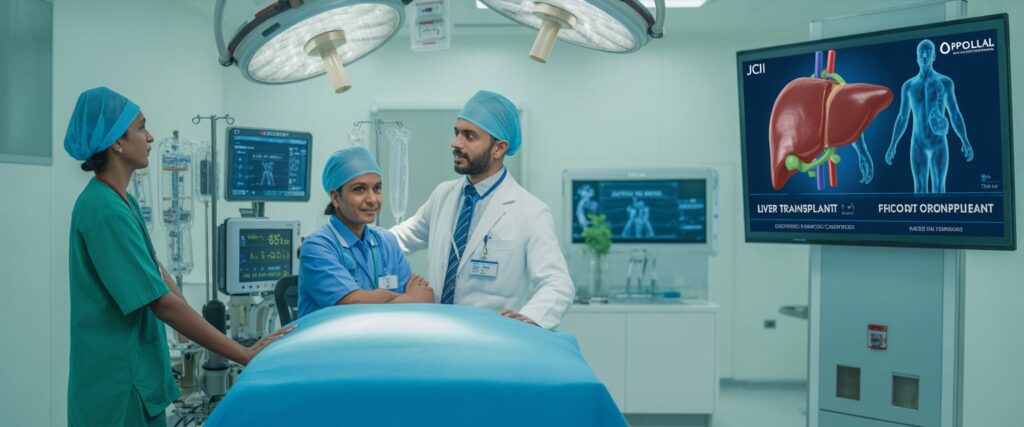Understanding the financial side of liver transplantation is crucial for families making life-saving decisions. With treatment costs varying widely across hospitals and cities, many patients struggle to choose the right medical care without feeling overwhelmed. This is where a clear and reliable comparison becomes essential. In this article, Liver Transplant Cost in India: Govt vs Private Guide offers a detailed breakdown of how expenses differ, what factors influence pricing, and which hospitals provide the best value for care.
Whether you are looking for subsidized government options or advanced private facilities, this Liver Transplant Cost in India: Govt vs Private Guide will help you make informed and confident decisions.
Liver Transplant Cost in India: Govt vs Private Guide
A liver transplant can save a life, but the cost often determines where and how it happens. In India, the cost of a liver transplant ranges from about ₹10 lakhs in government hospitals to ₹40 lakhs in private centers like Apollo Hospitals. This wide gap makes it essential to understand the options available, from free or subsidized treatments in public institutions to advanced facilities in private hospitals.
Hospitals such as AIIMS Delhi and ILBS Delhi offer lower-cost or government-supported transplants, while specialized centers like Medanta – The Medicity and Apollo provide advanced care with high success rates. Cities such as Chennai, Ahmedabad, and Kolkata have become important hubs for both living and cadaveric liver transplants, offering a range of options for patients across different budgets.

As the article continues, it explores how procedure types like auxiliary and cadaveric transplants affect cost, what influences success rates, and how financial aid programs help make this life-saving surgery more accessible.
Liver transplant expenses in India vary widely based on hospital type, location, and donor source. Government hospitals offer lower costs, while private centers like Apollo and Medanta provide faster access and advanced facilities. Financial aid programs and charitable trusts also help eligible patients receive treatment at little or no cost.
Liver Transplant Cost in Government Hospitals
Government hospitals provide some of the most affordable liver transplant options in India. Facilities such as AIIMS Delhi, ILBS Delhi, and Ahmedabad Civil Hospital perform transplants at a fraction of private hospital prices.
The average cost in these institutions ranges from $15,000 to $25,000 USD, depending on the patient’s condition and donor type. At AIIMS, the liver transplant cost is among the lowest nationwide, supported by government subsidies and teaching hospital infrastructure.
Patients may face longer waiting times due to limited donor availability and high demand. However, these hospitals maintain strict safety standards under NABH and JCI guidelines.
| Hospital | Estimated Cost (USD) | Accreditation |
|---|---|---|
| AIIMS Delhi | 15,000–25,000 | NABH |
| ILBS Delhi | 18,000–28,000 | JCI, NABH |
| Ahmedabad Civil Hospital | 16,000–25,000 | NABH |
Learn more about cost details and comparisons at Shifam Health’s 2025 guide.
Liver Transplant Cost in Apollo Hospital
Apollo Hospital is one of India’s leading private centers for liver transplants. It operates major transplant units in Delhi, Chennai, and Hyderabad, offering advanced care with high success rates.
The liver transplant cost in Apollo Hospital typically ranges between $35,000 and $50,000 USD, depending on the complexity of surgery and post-operative care. Packages usually include pre-surgery evaluation, donor screening, ICU stay, and three months of immunosuppressants.

Apollo’s world-class healthcare standards and experienced surgeons contribute to a 90%+ success rate. The hospital’s JCI accreditation ensures international quality and safety compliance.
More details are available in the Apollo cost overview.
Free Liver Transplant Hospitals in India
Several government and charitable programs in India help patients access free or subsidized liver transplants. Hospitals like AIIMS Delhi, ILBS Delhi, and Tamil Nadu Government Multi Super Specialty Hospital offer partial or full financial support for eligible low-income patients.
Nonprofit groups and crowdfunding platforms also assist families in raising funds. For example, ImpactGuru’s liver transplant guide highlights donation-based funding options.
Some state governments run health insurance schemes that fully cover transplant costs for residents below the poverty line. These initiatives aim to make life-saving surgeries accessible without compromising medical quality or post-surgery care.
Factors Affecting Liver Transplantation Cost
Several factors influence the cost of liver transplant in India. The donor type plays a major role—living donor transplants usually cost less than cadaveric liver transplants due to shorter waiting periods and planned procedures.
Hospital category also affects pricing. Government hospitals offer lower costs but longer waiting times, while private hospitals charge more for faster scheduling and advanced facilities.
Other cost drivers include surgeon experience, ICU stay length, immunosuppressant use, and post-operative complications. Cities like Chennai, Delhi, and Ahmedabad have slightly different pricing due to local healthcare costs.

Patients should review package inclusions carefully and confirm whether insurance covers transplant-related expenses, especially for international or high-value procedures.
Types of Liver Transplant Procedures and Success Rates
Liver transplantation can use different surgical approaches depending on the donor source and patient condition. Each method offers unique benefits and challenges related to recovery time, donor availability, and long-term outcomes.
Living Donor Liver Transplant
A living donor liver transplant uses a portion of a healthy person’s liver—usually from a relative or close match—to replace the diseased liver of a patient. The liver’s ability to regenerate allows both the donor’s and recipient’s livers to grow back to normal size within a few months.
This option helps reduce waiting time, which is critical for patients with end-stage liver disease or acute liver failure. Hospitals such as Mayo Clinic and Apollo have well-established living donor programs.

Living donor transplants often have shorter ischemia times and better outcomes due to the planned nature of the surgery. However, they require careful donor screening to minimize surgical risk. Success rates are high when performed at experienced centers with specialized transplant teams.
Deceased Donor (Cadaveric) Liver Transplant
A deceased donor liver transplant—also called a cadaveric liver transplant—uses a liver from a donor who has been declared brain-dead but whose organs are still functioning. The liver is preserved and transplanted into a recipient whose liver no longer works due to cirrhosis, hepatitis B, or other severe diseases.
According to Johns Hopkins Medicine, the entire liver or part of it can be transplanted, depending on the donor organ’s size and the recipient’s needs.
This type of transplant depends heavily on organ availability and matching. Waiting times can be long, especially in regions with fewer registered donors. Despite these challenges, outcomes are improving due to advances in organ preservation and post-operative care.
Auxiliary Liver Transplant
An auxiliary liver transplant involves implanting part of a donor liver alongside the patient’s existing liver instead of replacing it completely. This approach is mainly used for patients with acute liver failure or certain inherited liver disorders where the native liver may recover over time.
The technique allows the donor graft to support liver function temporarily. Once the patient’s own liver regenerates, the donor graft may shrink or be removed later.
Auxiliary transplantation is complex and performed only in select centers with advanced surgical expertise. It offers a bridge to recovery for patients who might otherwise require lifelong immunosuppressive therapy. The procedure is less common but valuable in specific clinical scenarios.
Liver Transplant Success Rate in India
The liver transplant success rate in India has improved markedly due to better surgical techniques, infection control, and post-transplant management. Leading institutions such as AIIMS Delhi, Medanta, and ILBS report success rates between 85% and 90% for adult liver transplants.
Outcomes depend on factors like donor type, recipient health, and hospital experience. Living donor transplants often show slightly higher survival rates than deceased donor procedures.
India’s transplant programs also benefit from specialized multidisciplinary teams and improved access to immunosuppressive drugs. As a result, both short-term and long-term patient survival continues to rise, making India one of the leading countries for advanced liver transplant care.
Top Liver Transplant Hospitals and Regional Insights
India offers advanced liver transplant programs supported by skilled surgeons and modern facilities. Major hospitals in cities like Delhi, Chennai, Kolkata, and Ahmedabad provide both living donor and cadaveric transplant options, with costs varying by hospital type and region.
Best Liver Transplant Hospitals in India
India’s leading liver transplant centers include Medanta – The Medicity (Gurugram), Indraprastha Apollo Hospital (New Delhi), Fortis Hospital (Noida and Mumbai), and Institute of Liver and Biliary Sciences (ILBS, Delhi). These hospitals maintain high success rates and follow international protocols for both adult and pediatric transplants.
Medanta operates one of the largest liver transplant programs in Asia, performing over 1,000 transplants annually. The Indraprastha Apollo Hospital is known for its multidisciplinary transplant team and advanced post-operative care. ILBS specializes in complex liver diseases and offers both living donor and cadaveric transplants.

Typical liver transplant costs in India range between ₹20–35 lakh in private hospitals, while government hospitals may offer subsidized or free transplants for eligible patients. The success rate in top Indian centers averages 85–90% for one-year survival, aligning with global standards.
Liver Transplant in Chennai
Chennai is a major hub for liver transplantation in South India. Hospitals like Apollo Hospitals, Gleneagles Global Health City, and Fortis Malar Hospital have dedicated liver transplant units with experienced surgical teams.
The Apollo Hospitals Chennai transplant program is one of the country’s oldest, with over 3,000 successful procedures. It provides both living donor and cadaveric transplants supported by advanced imaging and intensive care.
Liver transplant costs in Chennai usually range from ₹22–30 lakh, depending on the complexity and hospital. Some charitable trusts and government schemes help reduce expenses for low-income patients. The city’s hospitals maintain a one-year survival rate of around 90%, reflecting strong clinical outcomes.
Liver Transplant in Kolkata
Kolkata has developed strong transplant capabilities through hospitals like Apollo Multispeciality Hospital, Fortis Hospital Anandapur, and AMRI Hospitals. These centers perform both adult and pediatric liver transplants using international safety and quality standards.
The Apollo Multispeciality Hospital Kolkata offers a full-spectrum transplant program with experienced hepatologists and transplant surgeons. Fortis Anandapur provides advanced donor evaluation and post-transplant care, ensuring better recovery outcomes.
Costs for liver transplants in Kolkata range between ₹20–28 lakh in private hospitals. Government-supported hospitals may offer lower-cost options. The region’s success rate remains comparable to national averages, with well-established follow-up care improving long-term results.
Liver Transplant in Ahmedabad
Ahmedabad features both government and private options for liver transplantation. The Civil Hospital Ahmedabad provides one of the most affordable transplant programs in India, supported by state funding and public health initiatives.
Private hospitals such as Apollo Hospitals Ahmedabad and Sterling Hospitals also perform liver transplants with modern infrastructure and specialized transplant teams.
The Ahmedabad Civil Hospital offers liver transplants at significantly reduced costs, often under ₹10 lakh, making it a preferred choice for financially constrained patients. Private hospitals charge between ₹18–25 lakh, depending on donor type and medical condition.
Both government and private centers in Ahmedabad report growing transplant volumes and improved survival rates, supported by trained surgeons and better donor coordination programs.
Post-Transplant Care and Financial Assistance
Liver transplant patients need close medical follow-up, long-term medication, and access to financial help to manage ongoing expenses. Recovery depends on consistent care, proper insurance coverage, and support from hospital or government programs that reduce the cost burden.
Post-Operative Care and Recovery
After a liver transplant, patients stay in the intensive care unit for several days. Doctors monitor vital signs, liver function, and infection risk. Regular blood tests help track recovery progress.
Post-operative care includes immunosuppressant medications to prevent organ rejection. Patients usually take these drugs for life. A balanced diet, physical therapy, and regular checkups support long-term health.
Hospitals use advanced tools such as the Cavitron Ultrasonic Surgical Aspirator (CUSA) and argon laser coagulation during surgery to reduce blood loss and improve precision. These technologies help ensure exceptional care and faster recovery.
Transplant centers in India, such as AIIMS and ILBS, provide world-class healthcare with specialized transplant units and trained staff. Patients receive guidance on wound care, medication schedules, and signs of complications like fever or swelling.
Insurance and Government Schemes
Health insurance plays a major role in covering transplant costs. Most private insurers include liver transplants under critical illness or comprehensive health plans. However, coverage limits and waiting periods vary.
Government programs such as Ayushman Bharat–Pradhan Mantri Jan Arogya Yojana (PM-JAY) help low-income families access high-cost procedures at empaneled hospitals. State-specific schemes, like those in Tamil Nadu and Andhra Pradesh, also support transplant patients in government hospitals.
Some hospitals assist patients in applying for grants or reimbursement through charitable trusts. Patients can also explore nonprofit aid programs like the American Liver Foundation Financial Resources Guide and Help Hope Live’s transplant fundraising support.
Hospital Payment Plans
Private hospitals, including Apollo and Medanta, often provide installment payment options or cashless treatment for insured patients. These plans help families manage large bills by spreading payments over time.
Some transplant centers partner with banks or financial institutions to offer low-interest medical loans. Patients can also use crowdfunding platforms to raise funds for surgery and post-transplant care.
Government hospitals may charge minimal or no fees for eligible patients, especially under recognized public health schemes. Hospitals in cities like Chennai and Ahmedabad Civil Hospital have specific financial assistance desks to guide patients through available payment options.
Conclusion
Choosing the right hospital for a liver transplant requires balancing medical quality, affordability, and long-term care expectations. By understanding the cost variations between government and private hospitals, patients and families can better plan their treatment journey with clarity and confidence. This Liver Transplant Cost in India: Govt vs Private Guide highlights not only price differences but also the strengths of each healthcare sector, ensuring you know exactly what to expect. As you evaluate your options, let this Liver Transplant Cost in India: Govt vs Private Guide serve as a trusted reference to help you select the safest, most practical, and most compassionate care path.
Frequently Asked Questions
Liver transplant costs in India vary widely depending on the hospital type, city, and donor source. Major private hospitals charge significantly more than government facilities, but some public and charitable programs can reduce or even cover costs for eligible patients.
What is the cost of a liver transplant at government hospitals in India?
Government hospitals in India generally charge between ₹5–10 lakh for a liver transplant. Facilities such as AIIMS Delhi and Ahmedabad Civil Hospital offer lower-cost or subsidized procedures compared to private centers. The average national cost before insurance can exceed ₹8 crore ($1 million), but public hospitals cover much of this through government funding.
How much does a liver transplant cost at Apollo Hospital?
Apollo Hospitals, one of India’s largest private healthcare networks, usually charges between ₹22–30 lakh for a liver transplant. The cost depends on the patient’s condition, length of hospital stay, and whether a living or deceased donor is used. Apollo’s centers in Chennai, Delhi, and Hyderabad are among the most experienced in the country.
Which hospitals in India offer free liver transplant surgeries?
Some government and charitable institutions provide free or heavily subsidized liver transplants for low-income patients. These include AIIMS Delhi, Institute of Liver and Biliary Sciences (ILBS), and Tamil Nadu Government Multi Super Specialty Hospital. Certain state health insurance schemes and NGOs also fund transplant costs for eligible families.
What is an auxiliary liver transplant and where can it be performed?
An auxiliary liver transplant involves implanting a partial donor liver alongside the patient’s own liver. This procedure is used when the native liver has a chance to recover, such as in acute liver failure. Specialized centers like ILBS Delhi and Medanta Gurugram perform this complex surgery with multidisciplinary transplant teams.
Can you provide information on the success rate of liver transplants in India?
The success rate for liver transplants in India is high, with survival rates of 85–90% one year after surgery. Outcomes depend on donor type, patient health, and post-operative care. Leading hospitals such as Medanta, Apollo, and ILBS report results comparable to major international centers.
What are the best liver transplant hospitals in India?
Top liver transplant hospitals in India include Medanta – The Medicity (Gurugram), Apollo Hospitals (Chennai and Delhi), ILBS (Delhi), and Global Hospitals (Hyderabad). These centers have experienced surgical teams, advanced facilities, and high patient survival rates, making them preferred options for both domestic and international patients.
